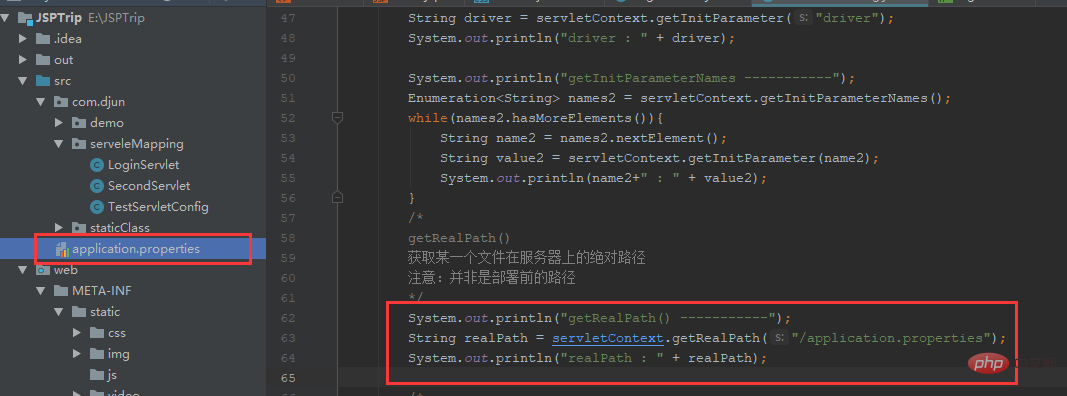Servlet JSP之 ServletConfig对象
ServletConfig对象有四个方法。

getInitParameter、 getInitParameterNames、 getServletName
(1)getInitParameter、 getInitParameterNames用于获取Web.xml中的参数名、参数值。
(2)getServletName 获取 Web.xml中的 Servlet-name。
实例
下面是Web.xml的文件内容:
<?xml version="1.0" encoding="UTF-8"?>
<web-app xmlns="http://xmlns.jcp.org/xml/ns/javaee"
xmlns:xsi="http://www.w3.org/2001/XMLSchema-instance"
xsi:schemaLocation="http://xmlns.jcp.org/xml/ns/javaee http://xmlns.jcp.org/xml/ns/javaee/web-app_4_0.xsd"
version="4.0">
<servlet>
<servlet-name>TestServletConfig</servlet-name>
<servlet-class>com.djun.serveleMapping.TestServletConfig</servlet-class>
<!--配置Servlet的初始化参数-->
<!-- 如何获取初始化的参数?
1、getInitParameter(String name)
Returns a String containing the value of the named initialization parameter,
or null if the parameter does not exist.
2、 getInitParameterNames()
Returns the names of the servlet's initialization parameters as an Enumeration of String objects,
or an empty Enumeration if the servlet has no initialization parameters.
-->
<init-param>
<param-name>username</param-name>
<param-value>admin</param-value>
</init-param>
<init-param>
<param-name>passworld</param-name>
<param-value>admin</param-value>
</init-param>
<!--
指定Servlet JSP被创建的时机
若数值 a<0,则仅在第一次的时候被创建。
若 a>=0 , 则在当前应用被Servlet容器加载时创建实例
数值越小越早被创建
-->
<load-on-startup>1</load-on-startup>
</servlet>
<servlet-mapping>
<servlet-name>TestServletConfig</servlet-name>
<!--只要后缀为html的文件都由该类处理-->
<url-pattern>/servletConfig</url-pattern>
</servlet-mapping>
</web-app>import javax.servlet.*;
import java.io.IOException;
import java.util.Enumeration;
public class TestServletConfig implements Servlet {
@Override
public void init(ServletConfig servletConfig) throws ServletException {
System.out.println("Init TestServletConfig...");
System.out.println("-----------执行getInitParameter--------");
String username = servletConfig.getInitParameter("username");
String passworld = servletConfig.getInitParameter("passworld");
System.out.println("username: " + username+"\n"+"password : "+passworld);
System.out.println("----------执行getInitParameterNames------");
Enumeration<String> names = servletConfig.getInitParameterNames();
while(names.hasMoreElements()){
String name = names.nextElement();
String value = servletConfig.getInitParameter(name);
System.out.println("username: " + name+"\n"+"password : "+value);
}
String servletName = servletConfig.getServletName();
System.out.println(servletName);
}
@Override
public ServletConfig getServletConfig() {
return null;
}
@Override
public void service(ServletRequest servletRequest, ServletResponse servletResponse) throws ServletException, IOException {
System.out.println("TestServletConfig....");
}
@Override
public String getServletInfo() {
return null;
}
@Override
public void destroy() {
}
}getServletContext
(1)Servlet为每个Web应用程序都创建了一个对应的ServletContext对象,ServletContext对象被包含在ServletConfig对象中,通过调用 ServletContext.getServletContext()方法可以返回ServletContext对象的引用。
(2) 由于一个Web应用程序中的所有Servlet都共享同一个ServletContext对象,所以,ServletContext对象被称为application对象(也就是web应用程序对象)。
(1) getRealPath()
获取某一个文件在服务器上的绝对路径,注意:并非是部署前的路径。
注意我的下面文件存放的目录
 (2) getContextPath()
(2) getContextPath()
获取当前Web应用的某一个文件对应的输入流。
System.out.println("getContextPath() -----------");
String contextPath = servletContext.getContextPath();
System.out.println(contextPath);
String fileName = "application.properties";
try {
File file = new File(realPath+ "/" + fileName);
ClassLoader classLoader = getClass().getClassLoader();
InputStream is = classLoader.getResourceAsStream(realPath + "/" + fileName);
System.out.println(realPath+ "/" + fileName);
System.out.println("1. "+ is);
} catch (Exception e) {
e.printStackTrace();
}Atas ialah kandungan terperinci Servlet JSP之 ServletConfig对象. Untuk maklumat lanjut, sila ikut artikel berkaitan lain di laman web China PHP!

Alat AI Hot

Undresser.AI Undress
Apl berkuasa AI untuk mencipta foto bogel yang realistik

AI Clothes Remover
Alat AI dalam talian untuk mengeluarkan pakaian daripada foto.

Undress AI Tool
Gambar buka pakaian secara percuma

Clothoff.io
Penyingkiran pakaian AI

AI Hentai Generator
Menjana ai hentai secara percuma.

Artikel Panas

Alat panas

Notepad++7.3.1
Editor kod yang mudah digunakan dan percuma

SublimeText3 versi Cina
Versi Cina, sangat mudah digunakan

Hantar Studio 13.0.1
Persekitaran pembangunan bersepadu PHP yang berkuasa

Dreamweaver CS6
Alat pembangunan web visual

SublimeText3 versi Mac
Perisian penyuntingan kod peringkat Tuhan (SublimeText3)

Topik panas
 1375
1375
 52
52
 Bagaimanakah mekanisme kelas muatan Java berfungsi, termasuk kelas yang berbeza dan model delegasi mereka?
Mar 17, 2025 pm 05:35 PM
Bagaimanakah mekanisme kelas muatan Java berfungsi, termasuk kelas yang berbeza dan model delegasi mereka?
Mar 17, 2025 pm 05:35 PM
Kelas kelas Java melibatkan pemuatan, menghubungkan, dan memulakan kelas menggunakan sistem hierarki dengan bootstrap, lanjutan, dan pemuat kelas aplikasi. Model delegasi induk memastikan kelas teras dimuatkan dahulu, yang mempengaruhi LOA kelas tersuai
 Bagaimanakah saya melaksanakan caching pelbagai peringkat dalam aplikasi java menggunakan perpustakaan seperti kafein atau cache jambu?
Mar 17, 2025 pm 05:44 PM
Bagaimanakah saya melaksanakan caching pelbagai peringkat dalam aplikasi java menggunakan perpustakaan seperti kafein atau cache jambu?
Mar 17, 2025 pm 05:44 PM
Artikel ini membincangkan pelaksanaan caching pelbagai peringkat di Java menggunakan kafein dan cache jambu untuk meningkatkan prestasi aplikasi. Ia meliputi persediaan, integrasi, dan faedah prestasi, bersama -sama dengan Pengurusan Dasar Konfigurasi dan Pengusiran PRA Terbaik
 Bagaimanakah saya dapat melaksanakan teknik pengaturcaraan berfungsi di Java?
Mar 11, 2025 pm 05:51 PM
Bagaimanakah saya dapat melaksanakan teknik pengaturcaraan berfungsi di Java?
Mar 11, 2025 pm 05:51 PM
Artikel ini meneroka mengintegrasikan pengaturcaraan berfungsi ke dalam Java menggunakan ekspresi Lambda, API Streams, rujukan kaedah, dan pilihan. Ia menyoroti faedah seperti kebolehbacaan dan kebolehkerjaan kod yang lebih baik melalui kesimpulan dan kebolehubahan
 Bagaimanakah saya boleh menggunakan JPA (Java Constence API) untuk pemetaan objek-objek dengan ciri-ciri canggih seperti caching dan malas malas?
Mar 17, 2025 pm 05:43 PM
Bagaimanakah saya boleh menggunakan JPA (Java Constence API) untuk pemetaan objek-objek dengan ciri-ciri canggih seperti caching dan malas malas?
Mar 17, 2025 pm 05:43 PM
Artikel ini membincangkan menggunakan JPA untuk pemetaan objek-relasi dengan ciri-ciri canggih seperti caching dan pemuatan malas. Ia meliputi persediaan, pemetaan entiti, dan amalan terbaik untuk mengoptimumkan prestasi sambil menonjolkan potensi perangkap. [159 aksara]
 Bagaimanakah saya menggunakan Maven atau Gradle untuk Pengurusan Projek Java Lanjutan, Membina Automasi, dan Resolusi Ketergantungan?
Mar 17, 2025 pm 05:46 PM
Bagaimanakah saya menggunakan Maven atau Gradle untuk Pengurusan Projek Java Lanjutan, Membina Automasi, dan Resolusi Ketergantungan?
Mar 17, 2025 pm 05:46 PM
Artikel ini membincangkan menggunakan Maven dan Gradle untuk Pengurusan Projek Java, membina automasi, dan resolusi pergantungan, membandingkan pendekatan dan strategi pengoptimuman mereka.
 Bagaimana saya menggunakan API Java's Nio (Input/Output Baru) untuk I/O yang tidak menyekat?
Mar 11, 2025 pm 05:51 PM
Bagaimana saya menggunakan API Java's Nio (Input/Output Baru) untuk I/O yang tidak menyekat?
Mar 11, 2025 pm 05:51 PM
Artikel ini menerangkan NIO API Java untuk I/O yang tidak menyekat, menggunakan pemilih dan saluran untuk mengendalikan pelbagai sambungan dengan cekap dengan satu benang. Ia memperincikan proses, faedah (skalabilitas, prestasi), dan potensi perangkap (kerumitan,
 Bagaimanakah saya membuat dan menggunakan perpustakaan Java Custom (fail JAR) dengan pengurusan versi dan pergantungan yang betul?
Mar 17, 2025 pm 05:45 PM
Bagaimanakah saya membuat dan menggunakan perpustakaan Java Custom (fail JAR) dengan pengurusan versi dan pergantungan yang betul?
Mar 17, 2025 pm 05:45 PM
Artikel ini membincangkan membuat dan menggunakan perpustakaan Java tersuai (fail balang) dengan pengurusan versi dan pergantungan yang betul, menggunakan alat seperti Maven dan Gradle.
 Bagaimana saya menggunakan API Soket Java untuk komunikasi rangkaian?
Mar 11, 2025 pm 05:53 PM
Bagaimana saya menggunakan API Soket Java untuk komunikasi rangkaian?
Mar 11, 2025 pm 05:53 PM
Artikel ini memperincikan API soket Java untuk komunikasi rangkaian, yang meliputi persediaan pelanggan-pelayan, pengendalian data, dan pertimbangan penting seperti pengurusan sumber, pengendalian ralat, dan keselamatan. Ia juga meneroka teknik pengoptimuman prestasi, i




